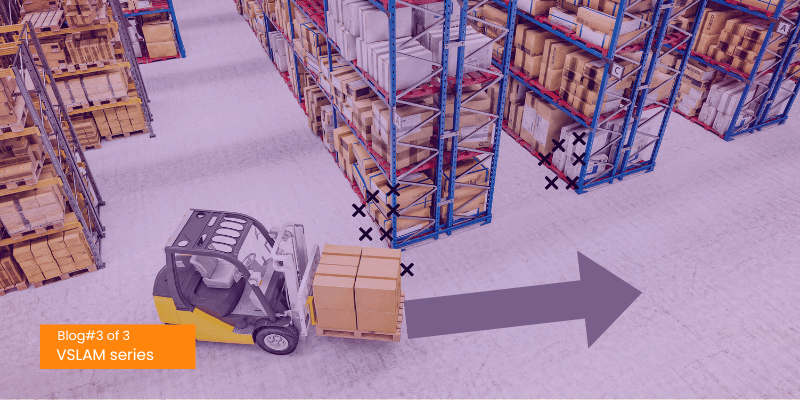- Srichitra S
- June 5, 2024
VSLAM Series - Loop Closure Detection
Introduction
In the third installment of our Visual SLAM series, we delve into the pivotal concept of loop closure. Building upon the foundational understanding laid out in the previous articles, we now embark on a journey to explore how loop closure enhances the robustness and accuracy of Simultaneous Localization and Mapping (SLAM) systems.
As we navigate through this crucial aspect of visual SLAM technology, we unravel its significance in enabling autonomous navigation, mapping, and localization in dynamic environments. For a better understanding of the content, check out the first and second part of this blog series that provides a comprehensive study of various aspects of visual SLAM.
Understanding Loop Closure
At its core, loop closure refers to the identification of previously visited locations in a robot’s trajectory. Imagine a scenario where a robot explores an environment, capturing visual data along its path. Loop closure detection enables the system to recognize when the robot revisits a location it has encountered before, thereby closing the loop in its trajectory. This capability is fundamental for accurate map building and localization, as it helps mitigate drift errors that accumulate over time.
Imagine you’re tasked with putting together a giant jigsaw puzzle, but you can only see a few pieces at a time. This is similar to how Visual SLAM (Simultaneous Localization and Mapping) works initially. The “frontend” quickly analyzes small sections of the environment, identifying key features like landmarks and estimating short-term trajectories. This provides a basic starting point for the map, but it is still like working with just a few puzzle pieces.
The “backend” of SLAM takes over to refine this initial picture. It acts like a meticulous puzzler, trying to fit everything together seamlessly. However, if the backend relies solely on connections between neighboring pieces (like in Visual Odometry), errors creep in over time. Each connection introduces a small inaccuracy, and these errors build upon each other like dominoes falling. This leads to a distorted final map, just like the puzzle wouldn’t be complete or accurate if you only considered connections between adjacent pieces.
To create a truly accurate and consistent map, SLAM needs a way to recognize when it has revisited a familiar location. This is like realizing you’ve stumbled upon the same exact corner piece of the puzzle multiple times while exploring different sections. This information, known as loop closure, is crucial for the backend. It allows SLAM to establish global consistency, ensuring that all the puzzle pieces eventually fit together perfectly, and the final map accurately reflects the entire environment.
Check out the illustration below to see VSLAM loop closure in action.

This loop closure capability serves two key purposes:
- Improved Accuracy:
Loop detection helps correct errors that accumulate over time in the estimated trajectory and map. By recognizing familiar locations, the system can adjust its position and refine the overall map, leading to a more accurate representation of the environment. - Enhanced Robustness:
Loop detection enables a powerful feature called relocation. Imagine recording a reference path for a robot beforehand. With relocation, the robot can determine its position on this pre-recorded track, even if it encounters unexpected obstacles or sensor errors. This significantly improves the system’s ability to navigate reliably.
The Impact of Loop Closure on SLAM Maps
(a) Without Loop Closure:
This image shows a map created using a monocular vision-based SLAM system (one camera). The inner curve represents the robot’s path, and the outer points represent the mapped features. Notice how the path appears to drift away from the actual trajectory. This is because errors in estimating the robot’s movement accumulate over time without loop closure.
(b) With Loop Closure:
This image demonstrates the significant improvement achieved by using loop closure in the same SLAM system. The robot’s path (inner curve) is much straighter and aligns better with the actual trajectory. The map features (outer points) are also more tightly clustered and likely represent the environment more accurately. Loop closure helps the system recognize previously visited locations, correct accumulated errors, and generate a more consistent and reliable map.
Implementing Loop Closure
When considering the implementation of loop closure detection in visual SLAM systems, various theoretical and engineering approaches come into play, each with its own advantages and limitations. One straightforward method involves performing feature matching on image pairs to determine relatedness based on the number of correct matches. While simple and effective, this approach assumes that any two images could potentially form a loop, resulting in a prohibitively large number of comparisons, especially as the trajectory lengthens, making it impractical for real-time systems.
Another approach involves randomly selecting historical data and performing loop detection on subsets of frames. While this maintains constant calculation time, as the number of frames increases, the probability of detecting a loop decreases, leading to reduced detection efficiency.
To refine these coarse methods, more sophisticated approaches consider predictive cues to narrow down potential loop candidates. These can be broadly categorized into odometry-based or appearance-based methods.
Odometry-based methods rely on geometric relationships, detecting loop closures when the current camera position closely resembles a previous position. However, estimating accumulated drift accurately is challenging without global position measurements like GPS, and this approach assumes small cumulative errors, rendering it ineffective when errors accumulate significantly.
On the other hand, appearance-based methods focus solely on image similarity to determine loop closure relationships, independent of frontend or backend estimation. This approach eliminates accumulated errors and has become the mainstream method in visual SLAM systems. By calculating the similarity score between images, loop closures can be identified effectively across various scenarios.
However, determining image similarity is not straightforward due to factors like perceptual aliasing and variability. Directly subtracting pixel values between images often yields unrealistic differences due to environmental factors like lighting changes and viewpoint variations. Consequently, defining a function to accurately reflect image similarity becomes crucial, considering perceptual aliasing and variability.
Precision and Recall
From a human perspective, determining whether two images were taken from the same place or are similar is intuitive, yet articulating precisely how our brains achieve this remains elusive. However, in the realm of computer programs, we aim for algorithms to make judgments consistent with human perception or objective facts. Just like in machine learning, where algorithms may not always align with human thinking, loop detection algorithms may yield four possible outcomes: true positives (TP), true negatives (TN), false positives (FP), and false negatives (FN).
These terms describe perceptual bias (false positives) and perceptual variation (false negatives). To evaluate loop detection algorithms, we employ two key statistics: accuracy rate and recall rate (also known as precision and recall). Accuracy rate measures the likelihood that all loops detected by the algorithm are true, while recall rate indicates the probability of detecting all real loops.
Since algorithms often have multiple parameters, such as thresholds, adjusting these parameters affects the trade-off between accuracy and recall. A higher threshold may improve accuracy by reducing false positives but could lead to missed real loops, lowering recall. Conversely, a lower threshold increases recall but might introduce more false positives, decreasing accuracy.
To assess algorithm quality, precision-recall curves are constructed, mapping recall rate against accuracy rate. The curve’s shape indicates the algorithm’s performance across different parameter configurations. In SLAM, where accuracy is paramount, we prioritize strict parameters or include loop verification steps to mitigate false positives. While lower recall may result in missed loops and accumulated errors, remaining loops could correct them.
Returning to the question of why we don’t directly use image differencing (A – B) to calculate similarity, empirical evidence shows that its accuracy and recall fall short compared to current methods, leading to numerous false positives or negatives. Thus, we opt for more sophisticated techniques that better capture image similarity and align with the precision and recall requirements of loop closure detection in visual SLAM systems.
Bag Of Words
The Bag-of-Words (BoW) [briefly explained in the first blog of this series] concept aims to describe an image in terms of the types of features present within it. For instance, consider two images—one containing a person and a car, and the other featuring two people and a dog. By encoding these features into a description, we can measure the similarity between the images. This process involves:
- Defining concepts like “person,” “car,” and “dog” as words, which are compiled into a dictionary.
- Detecting which predefined words from the dictionary appear in an image. The appearance of these words is represented by a histogram, providing a vector description of the entire image.
- Computing similarity between images based on the histograms generated in the previous step.
Conclusion
In conclusion, loop closure detection is the cornerstone of robust and accurate visual SLAM. By recognizing revisits to previously explored areas, it corrects errors that accumulate over time and allows the system to build a globally consistent map. This enhanced map, coupled with the ability to relocate using pre-recorded paths, paves the way for reliable and dependable robot navigation in complex environments. As research in loop closure detection continues to advance, we can expect even more sophisticated SLAM systems capable of navigating uncharted territories with remarkable precision and confidence.





































